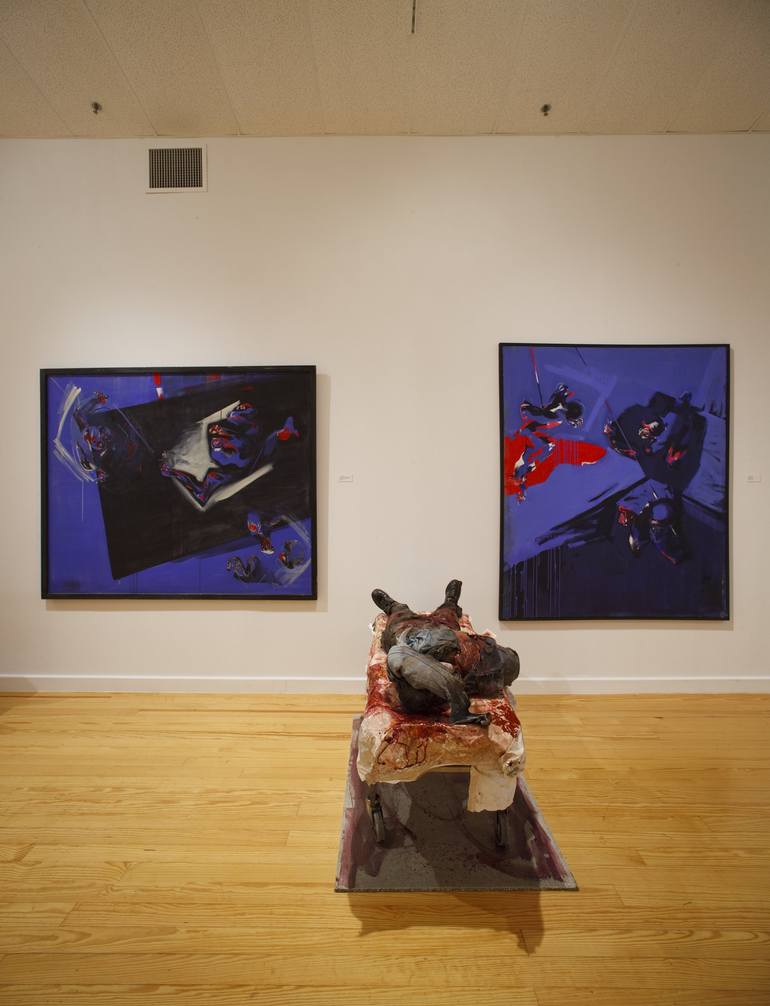


VIEW IN MY ROOM
Inquisition Series Painting
Spain
Painting, Acrylic on Other
Size: 65 W x 75 H x 1 D in
About The Artwork
Station Museum Of Contemporary Art. Houston 2009. Javier de Villota’s beautifully conceived paintings on the subject of the European Inquisition represent his meditations on human suffering and on the horror of the Inquisition. By conferring beauty, emotion, transparency, and the honesty of Abstract-Expressionism on this subject, Villota’s paintings illuminate and transcend the Inquisition’s violent history. Pope Lucius III created the Inquisition in the twelfth century to combat the Albigensian heresy in Southern France, but it went on to plague Europe and the Americas for nearly seven centuries. Its administration was through tribunals, and its penalties included torture, imprisonment, and death sentences. Over the first three centuries, the Inquisition spread through much of Europe in its quest for heretics and enemies, even as its influence steadily declined. In France, England and Germany, the Inquisition degenerated into outbursts of racist violence against Jews and foreigners. However, in Spain and in her Empire, the Inquisition, no longer an exclusive ecclesiastical agency of the Pope, became more virulent as a political organ of the Spanish King and lasted well into the 19th century. The importance of the Inquisition for today’s audience is that an Inquisition has reappeared many times in different guises; for example, Stalin’s “kangaroo trials” of the 1930s and George Bush’s “War on Terror.” **Texts by James Harithas. Station Museum of Contemporary Art Director
Details & Dimensions
Painting:Acrylic on Other
Original:One-of-a-kind Artwork
Size:65 W x 75 H x 1 D in
Frame:Not Framed
Ready to Hang:No
Shipping & Returns
Delivery Time:Typically 5-7 business days for domestic shipments, 10-14 business days for international shipments.
Have additional questions?
Please visit our help section or contact us.
"In a short period of time, from the first half of the 20th century to the onslaught of two World Wars and the Spanish Civil War, with his Manifest of Insanity and Lack of Reason, corrupted by the unimaginable corruption of the gas chambers, en mass executions and cremations, the generation that lives and is born during this reinvented apocalyptic period, does so from this perturbing point of view, like Bacon, Dubuffet, De Kooning etc...exhibits like "The Images of Man" (MOMA, New York City, 1959). The new aesthetic is irreversible. The human being passes from the optimistic fruit of reason to corrupted and shredded bodies." Javier de Villota, Madrid 1944, belongs to this generation of some men reared by force. Among this, we could say that Villota's occupies a preeminent position, for his extreme sensibility and ease with which he expresses himself through the use of plastic expressions Javier de Villota is an important Spanish artist, who is devoted to issues of human freedom and human rights. His artistic labor develops in the fields of painting, sculpture and architecture. Villota is the third generation from his family dedicated to the arts, being worth to mention the influence in his work of his great uncle Jose Gutierrez Solana Working for several years (1970-1976), after graduating from the Technical University of Architecture (Escuela Técnica Superior de Arquitectura) as a professor in Shapes Analysis, and as a drawing professor at Escuela de Artes y Oficios, he is represented in some of the most important museum permanent collections around the world such as Museo Reina Sofia and Academia de San Fernado de Bellas Artes in Spain, Museo de Arte Contemporaneo in Santiago de Chile, Museo Nacional de Arte in Bolivia, and Station Musem in Texas, United States. "His paintings are Abstract Expressionist in style, as befits his political orientation, and at the same time, they show a debt to his heritage, particularly to Francisco Goya. The biography of de Villota's work is a constant search for new plastic spaces joined by the concern of man in his greatest state of awareness and sentiment. There, when man is entwined with pain, loneliness, and absence. Through this unambiguous approach to painting, he communicates his humanist message on several levels. On one hand, his paintings are a personal visual record of his own pain and anxiety as he contemplates life's cruelty.
Thousands Of Five-Star Reviews
We deliver world-class customer service to all of our art buyers.
Global Selection
Explore an unparalleled artwork selection by artists from around the world.
Satisfaction Guaranteed
Our 14-day satisfaction guarantee allows you to buy with confidence.
Support An Artist With Every Purchase
We pay our artists more on every sale than other galleries.
Need More Help?